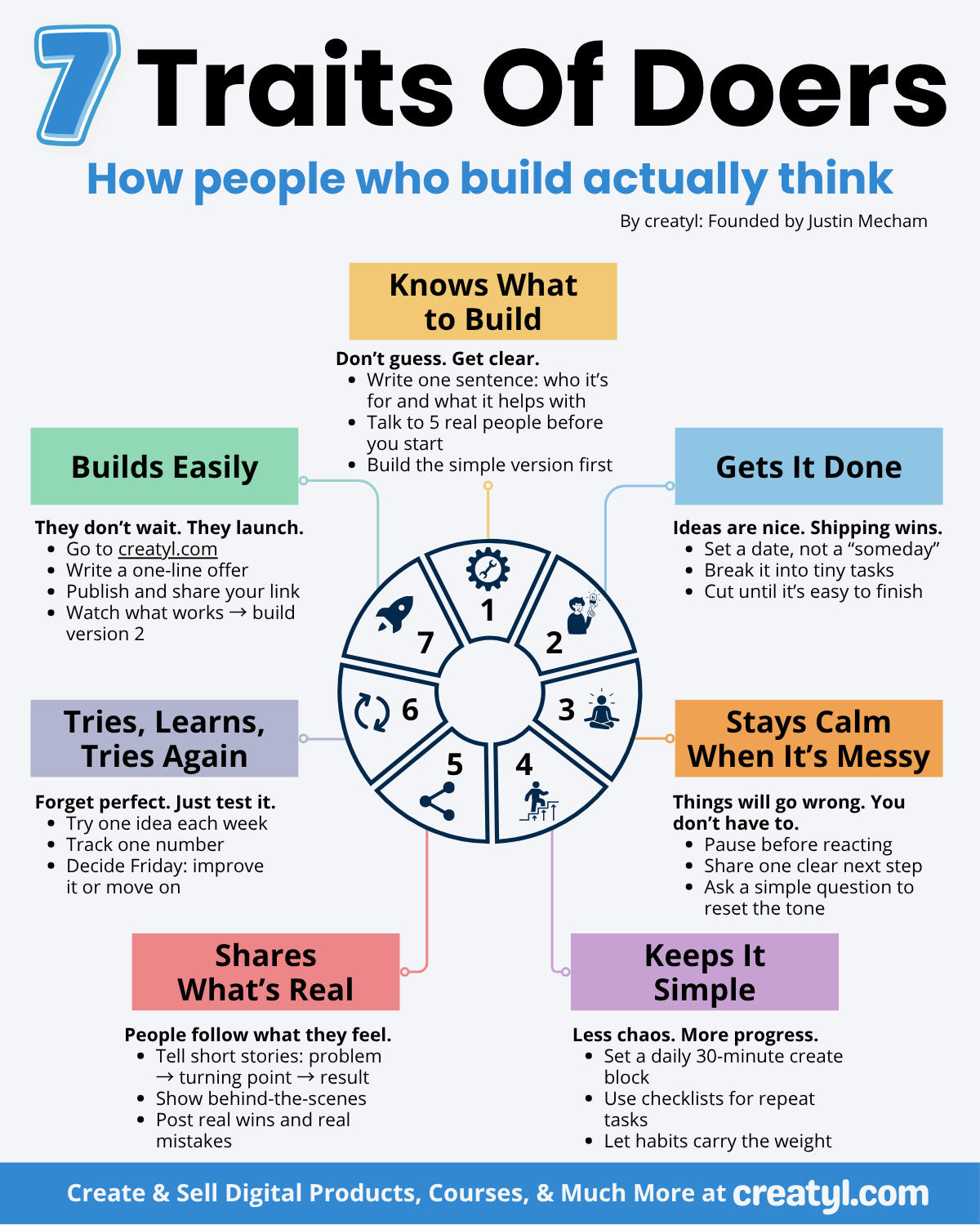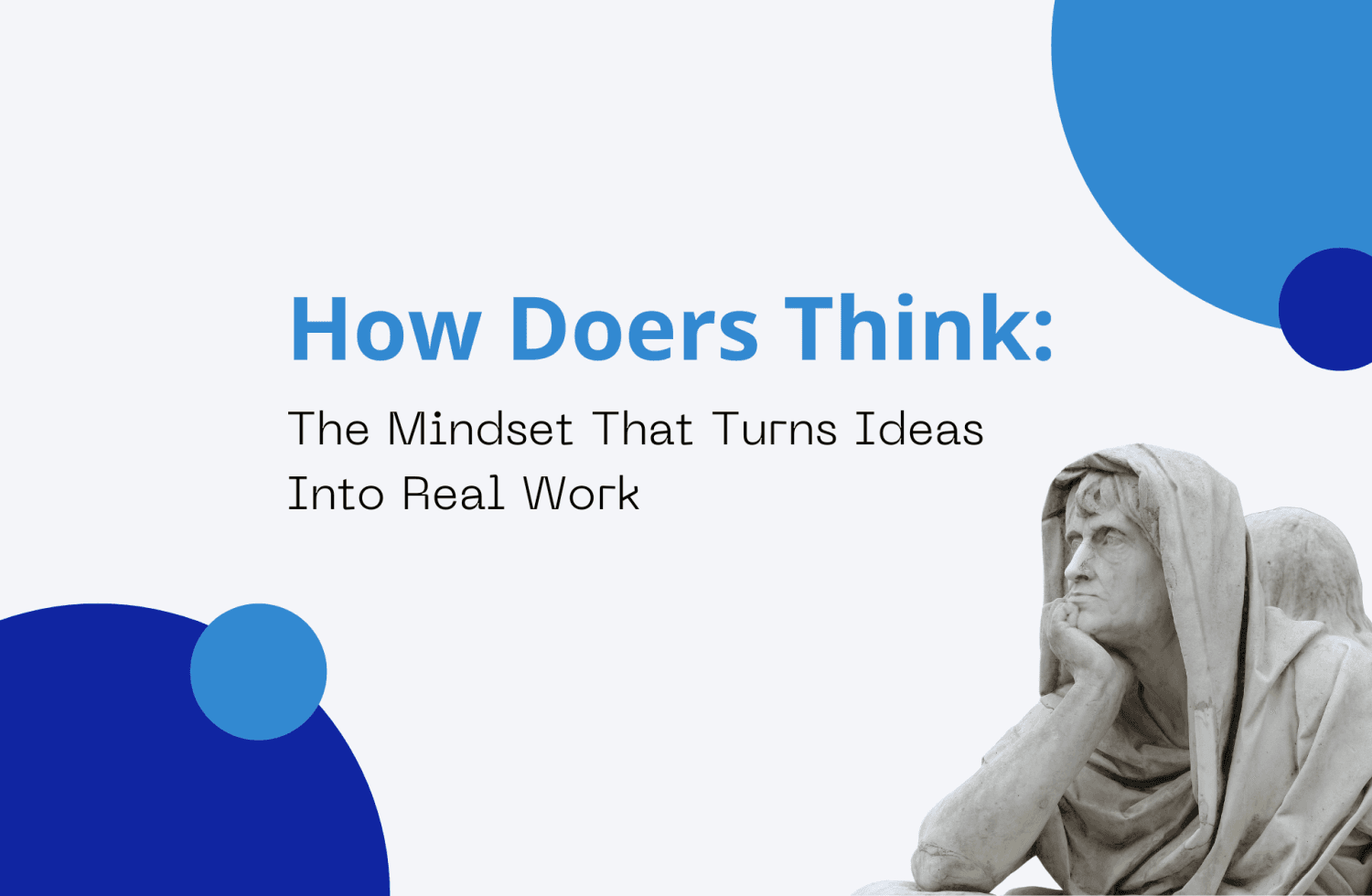Click Here to Download The PDF
Let’s just say it out loud: most people aren’t lazy.
They’re not unmotivated.
They’re not lacking talent.
They’re just waiting.
Waiting to feel ready.
Waiting until the idea is “better.”
Waiting for someone to give them a sign.
The problem? Waiting feels safe… until you look around and realize it’s been 6 months and you’re still sitting on the same draft, the same idea, the same “maybe one day.”
That’s the trap.
Meanwhile, doers—people who build, launch, try, learn, and show up consistently—they’re not waiting.
They’re not perfect, they’re not fearless, and they definitely don’t always know what they’re doing.
But they move anyway.
They build clarity through action.
They make messes and keep going.
They put something real in the world, even when it’s unfinished.
And that’s why they win.
In this article, we’re going to break down the 7 traits that separate doers from everyone else.
Not the fluffy motivational stuff. The real behaviors that actually make things happen—at work, in projects, in ideas that turn into income.
We’ll also give you:
- A real-world example for each trait (using the PAS method)
- Clear ways to apply it starting this week
- One powerful book, tool, or talk to help you go deeper
- A downloadable infographic to keep you moving
No theory. No fluff. Let’s go.
1. Clarity First
They don’t start by building. They start by getting clear.
Doers don’t wait for someone else to define the problem for them.
They take 20 minutes to do something most people skip—figuring out exactly what they’re solving, who it’s for, and how to say it in one simple sentence.
They don’t try to make things for “everyone.” They focus on one person. One problem. One promise.
Real-World Example:
A product designer at a startup was in charge of revamping the onboarding experience. Three teams had given her feedback, all contradicting each other. The design kept changing every week.
It was turning into a mess—15 different screens, 9 rounds of revisions, zero clarity.
She paused the project, shut off Slack, and asked herself:
What is this actually for?
She wrote one sentence:
“This onboarding helps new users send their first message in under 3 minutes.”
That became her north star.
It simplified every decision.
The revised flow was finished in two days, launched that same week—and retention spiked.
How to Apply It:
- Write one clear sentence: who it’s for, what it helps with
- Say it out loud to your team before you build anything
- Use it to cut anything that doesn’t align
Book to Support This:
Atomic Habits by James Clear
A masterclass in building identity-based habits that help you become the kind of person who follows through with clarity and consistency.
2. Action Over Ideas
They don’t wait for the perfect version. They ship the simplest version now.
Everyone has ideas.
What separates doers is that they don’t get trapped trying to build the dream version before putting anything out there.
They start small. They set deadlines. They make cuts. And they publish.
Real-World Example:
A client team wanted to build a referral program. The original idea was simple—one landing page, one email, a thank-you discount.
But then… it spiraled.
They added custom dashboards, tiers, loyalty points, and eventually a backend system that wasn’t even scoped yet.
After two months of "almost there," a senior manager asked the obvious question:
“Why haven’t we launched anything?”
So they cut everything except the core:
One Google Form.
One thank-you email.
One simple link.
They launched it in three days.
Over 600 users joined in the first 48 hours.
Real data started rolling in. They refined it based on that—not more hypotheticals.
How to Apply It:
- Choose a ship date before you finish the idea
- Cut scope until it fits into 3–5 hours of work
- Publish something real, then learn from it
TED Talk to Watch:
The Science of Taking Action by Steve Garguilo
A powerful breakdown of how to stop overthinking and start taking bold, practical action right away.
3. Steady Under Pressure
They stay calm when things break—and they always do.
Being a doer doesn’t mean you’re never stressed. It means you’ve learned how to respond without unraveling.
When things go sideways (which they will), most people freeze or react emotionally. Doers pause, breathe, and make the next smart move.
Real-World Example:
A marketing team had just launched their biggest campaign of the quarter. The results? Not great.
Click-throughs tanked. Social comments were negative. One exec even asked if they should shut it down immediately.
Tensions flared.
People started defending their work.
Slack was on fire.
The team lead called a quick huddle. And instead of going into defense mode, she asked:
“What’s the one change we can make by the end of today to test a new angle?”
They rewrote the headline and changed the call to action. Ran a new version to a smaller audience.
By the next morning, engagement had doubled.
It wasn’t a full fix—but it kept the team grounded, focused, and moving forward instead of falling apart.
How to Apply It:
- When things get messy, pause. Don’t react right away.
- Ask: “What’s one useful step we can take in the next 24 hours?”
- Reset the tone of the team by modeling calm, not panic
Book to Support This:
The Obstacle Is the Way by Ryan Holiday
A modern guide to stoic thinking that shows how calm, grounded action often creates the best path forward—especially in pressure-filled moments.
4. Keep It Simple
They do fewer things, more often, with more consistency.
Most people are overwhelmed—not because they have too much to do, but because everything feels equally urgent.
Doers simplify.
They build repeatable systems.
They stop overplanning and start creating daily blocks that actually protect time and focus.
Real-World Example:
A freelancer running multiple client projects was falling behind on deadlines. She was constantly busy, but progress felt random. She kept jumping between tasks and ended most days feeling like she got nothing meaningful done.
So she made a change:
Every day at 1 p.m., she blocked off 30 minutes. No Slack. No calls. No notifications.
This was her “creation window.”
She’d use it to write, design, or solve one thorny issue—just one.
She also made a checklist of 4 weekly wins:
- One new piece of content
- One delivery milestone
- One sales outreach
- One thing she automated or removed
That small system changed everything. She stopped feeling behind and started feeling in control.
How to Apply It:
- Block 30 minutes per day at the same time—every day
- Use one simple checklist to define a “successful week”
- Let everything else be optional
Tool to Support This:
Notion or Coda
Create your own "Doer Dashboard" with checklists, tasks, and daily rituals that make momentum easier to repeat.
5. Share the Real Stuff
They tell the truth—especially when it’s not perfect.
Doers don’t try to look like they have it all together. They talk about the hard parts. They share their version 1. They post before it’s shiny.
And that honesty builds connection—because people don’t follow perfection. They follow real.
Real-World Example:
A solopreneur spent months curating beautiful posts. Clean visuals. Insightful tips. Zero traction.
No likes. No leads. Just silence.
They decided to try something else. One Friday afternoon, they posted a thread about a failed client launch—what went wrong, how they handled it, and what they’d do differently next time.
It wasn’t strategic. It was just honest.
That post took off.
DMs flooded in.
Someone shared it in a Slack community.
The next week, they booked two new clients.
Why?
Because people could finally see themselves in what was shared.
How to Apply It:
- Once per week, post or share something unfinished, unpolished, or imperfect
- Use this structure: what happened → what you learned → what you’re doing next
- Stop hiding behind the highlight reel
Book to Support This:
Daring Greatly by Brené Brown
A powerful guide on how honesty, vulnerability, and truth-telling lead to better leadership, stronger relationships, and more impact.
6. Test, Don’t Wait
They don’t plan forever. They test fast and adjust in real time.
The biggest trap most builders fall into? Thinking they need to get it all right before they launch.
Doers understand that everything is a test—and the faster you get data, the faster you improve.
Real-World Example:
A team wanted to create a dashboard for internal analytics. Six weeks in, it still hadn’t been shared with users. No one had seen anything. The engineers kept pushing for more specs.
Eventually, a team member suggested building a spreadsheet version in 2 days.
They did.
They gave it to 5 team leads and said: “Use this for 3 days and tell us what’s missing.”
That test surfaced insights no meeting ever did.
Half the original features weren’t even needed.
They rebuilt the dashboard in one week—and everyone actually used it.
How to Apply It:
- Build the simplest version of your idea in under 3 days
- Share it with 3 real users or team members
- Decide: improve or move on
Tool to Support This:
Tally + Google Sheets
Fast, lightweight tools for launching MVPs, forms, or content without getting bogged down by code.
7. Build Fast
They launch small—and learn loud.
Doers don’t chase perfect. They chase real feedback.
They publish the rough draft. They get users in early. And they learn more in one week of usage than in three months of planning.
Real-World Example:
An agency team had an idea to launch a new digital product—a kit of branding templates.
They wanted it to look perfect before launch. Custom landing page. Checkout flow. Full email sequence. Branded demo.
Six weeks in, nothing was live. Then a competitor launched something almost identical.
That night, they stripped everything down.
They took one template.
Uploaded it to a shared folder.
Made a Stripe payment link.
Posted it as a beta test on their LinkedIn.
In 72 hours, they had 23 purchases.
And a waitlist for the full version.
That simple beta became their best-selling product of the quarter.
How to Apply It:
- Launch version 0.1 with the simplest path: one page, one offer, one link
- Don’t wait for perfect—wait for feedback
- Let that feedback write your next version
Tool to Support This:
ChatGPT
Use it to generate fast copy, ideas, names, and even first-draft content—so you can publish your version 1 before the momentum disappears.
Final Thought: Where Doers Begin
You don’t need more time. You need less waiting.
There will always be reasons not to start.
The copy isn’t done.
The design isn’t quite right.
The idea could still be better.
And yet—nothing teaches faster than movement.
Nothing builds confidence like action.
And nothing opens doors like showing up, even when it’s messy.
Doers don’t act because they have all the answers.
They act because they know clarity comes from action—not the other way around.
Every big thing you’ve ever admired started as a version 1.
So if today feels rough, unclear, or unfinished—you’re not behind.
You’re in the right place.
Because doing something imperfect is the fastest path to everything you're waiting for.
Want the Infographic as a PDF?
If you want to keep these 7 traits close—so you can actually use them when things feel stuck—download the full “7 Traits of Doers” infographic in a clean, printable PDF format.
Perfect to save, reference, or share with your team.




